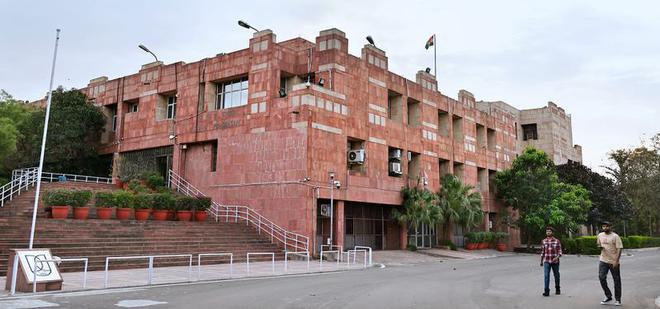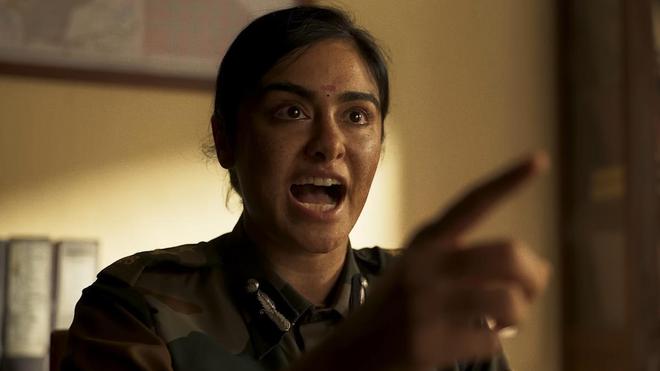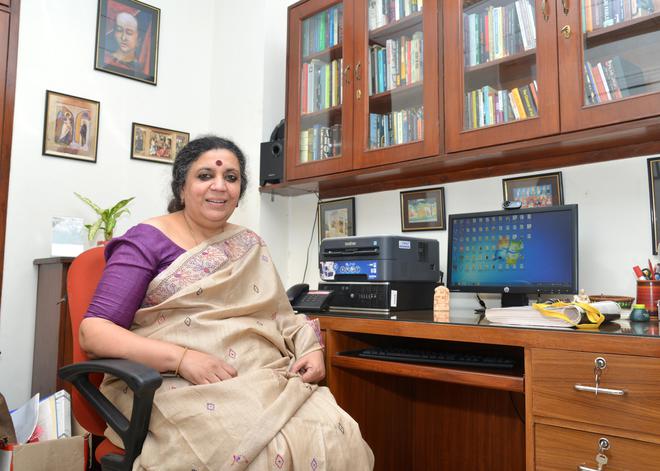On April 10, the day World QS rankings declared Delhi’s Jawaharlal Nehru University (JNU) as India’s top-ranked university, JNU’s Narmada hostel lights up at 9 p.m. As students eat dinner in the mess and wrap up for the night, two young men use markers to write ‘Hastinapur University’ on chart paper stuck in front of the hostel. Three vans with film equipment are parked outside and dozens of actors are getting ready for the shooting of a web series by filmmaker Sudhir Mishra on students during India’s Emergency.
A group of five first-year students from the Centre of Russian Studies walks past the shoot location, but what piques their interest is the activity in the building opposite the hostel — the office of the university’s student union (JNUSU). Here, the All India Students Association (AISA) is holding a public hearing on what it believes is the commercialisation of the campus. The students sit on the steps of the building and listen in. Inside, about 30 people are in the audience as Sucheta De, CPI(ML) member and former JNUSU president, speaks about how JNU is a “blend of worlds and experiences” and that there are concerted attempts to change what it stands for.
As the five students, from different parts of the country, discuss the shooting of the web series, the conversation quickly segues into the new narrative being built around JNU. They talk about how this had almost prevented their families from letting them take admission here. One of them says, “JNU ke baahar jao, toh log antankwadi bulana shuru kar lete hai (When we step out of campus, people start calling us terrorists).”
Established in 1969, JNU is spread across over 1,000 acres, with 10 schools and 18 hostels constructed in the exposed-brick style. Students and teachers believe that the university is politically conscious as it fosters a culture of discussion and debate, both inside the classroom and outside, in its green spaces and dhabas.
On its website, the university says it is a “world-renowned centre for teaching and research” that follows a “somewhat unorthodox academic structure”. At the heart of the conflict between JNU’s external perception and its internal workings are two Hindi films the university features in: Bastar: The Naxal Story, which released in March, and JNU: Jahangir National University, slated to hit theatres soon.
Bastar was marketed as based on real-life incidents from the Maoist insurgency in Chhattisgarh’s Bastar. In the trailer, actor Adah Sharma, who plays an IPS officer, mentions in a speech that 15,000 jawans had been killed by Naxalites. She adds that the massacre of 76 soldiers of the Central Reserve Police Force was celebrated in JNU. “Imagine... that such a prestigious university celebrates the killing of our jawans. Where does this thought process come from?” she says.
The poster for Jahangir National University features the tag line, “Can one educational institution break the nation?”, with a visual of a map of India painted saffron being crushed in a hand.

The student experience
Garwita Gandhi, one of the first-year students from the Centre of Russian Studies, says she was “angered” at the depiction of the university as a subversive body in Bastar’s trailer. It was this perception that Gandhi, who hails from Uttar Pradesh’s Jaunpur, had to fight when she secured admission last August. “My uncle used to think that the campus is meant only for students who want to get into politics,” she says.
Even after her year-long stint here, he still believes that “there is too much violence on campus”. After a pause, she adds, “It took me some time to convince my family to let me come here, to make them understand that this perception is not true.” She says the perception is created when incidents are blown out of proportion on TV channels and such films are made. Gandhi says she joined JNU for her love for languages and job prospects as a translator that come after such a degree. The School of Language, Literature and Culture Studies has 12 centres, including one for Arabic and African Studies and another for Chinese and South-East Asian Studies.
By now, it is 11 p.m., when it is customary for students to walk around campus, a safe space to talk about everything from parents to politics. The hostels are never shut and there is no ‘Lakshman Rekha’ around women’s movement.
Ayush Rawat, Gandhi’s classmate, says, “Whenever there is a protest on campus, there are comments online abusing students, branding them as terrorists. And students reply calmly, explaining the cause for their agitation.” The students’ replies stood out for him in the middle of all the rumble, drawing him to the university. For Anjali Mehra, her friends from other colleges reacted to the incidents on campus before she had even found out about them.
The classmates say while they have not joined any student outfit yet, they routinely attend protests that address student issues, such as a water crisis in the hostel and justice in a sexual harassment case. They say their experience so far has been defined by key moments such as “jamming at PSR (Parthasarathy Rocks), eating at Ganga dhaba, and protesting outside the DoS (Dean of Students) building”.
These experiences are not vastly different from the memories that writer, filmmaker, and oral historian Sohail Hashmi recalls. JNU was home from 1972 to 1981 for Hashmi, who was part of the university’s first MA batch and studied Geography. He was also a student counsellor in 1972-1973, where his role was to flag any issues students were facing with the central panel, the elected student leaders. “There was always music on campus, and we went to our professors’ homes on Holi, Id, and Diwali every year. At the same time, we fought for struggles for freedom all over the world,” he fondly remembers.
“All these years later, students fought during the anti-CAA [Citizenship (Amendment) Act] and farmers’ protests. Of course, JNU will be portrayed negatively because nobody wants students to be political, it makes it difficult for their [the ruling party’s] politics to survive.”

The films in question
Nearly a year before Bastar, the controversial Hindi film, The Kerala Story, was released by the same team: producer Vipul Shah, director Sudipto Sen, and actor Adah Sharma. Marketed as a true story, it revolves around three women who were “indoctrinated and forced to join the terrorist organisation, ISIS”. The promotions for the movie incorrectly claimed that 32,000 women from the southern State had been forcefully converted to Islam and made to join the terror group, which the team had to later retract.
After the release of Bastar’s teaser in February, sections of JNU students protested on campus calling it “hate propaganda”. On X (formerly Twitter), former JNUSU president Aishe Ghosh had demanded immediate action against the makers for the “open call for genocide of JNU students”. Despite resistance by the Students’ Federation of India (SFI), student wing of the Communist Party of India (Marxist), JNU’s Rashtriya Kala Manch unit, a wing of the Akhil Bharatiya Vidyarthi Parishad (ABVP), student wing of the Rashtriya Swayamsevak Sangh, that aims at promoting art and culture, organised a screening of the film on campus, for which Sen was present.
Responding to questions about the backlash, Shah says, “What we showed was true; we were not taking sides. The protesting students should look within and stop anti-national activity.” The movie, though, had called for the “public execution of left-leaning pseudo-intellectuals” of big cities who “side with Naxals”. Clarifying, he says, “The character in the film speaks of two unrelated issues: JNU celebrating the killings, and pseudo-intellectuals who side with Naxals. We did not brand JNU students in any way.”
Jahangir National University revolves around a right-wing student leader, Sourabh Sharma, shows him getting restless with “the various activities of left-wing students who are anti-national”, and his fight against them. The film also features a character playing a left-wing student leader named Arushi Ghosh.
Aishe, who has not seen the film, laughs as she says, “I’m supposedly the villain and Saurabh is the hero.” The movie’s protagonist is believed to be based on Saurabh Sharma, who was her contemporary in JNU and an ABVP member. She has approached the Delhi High Court over the film’s content, and the matter is yet to be listed for hearing. Supratik Sarkar, Aishe’s lawyer, says the film was due for release on April 5. The film’s director did not respond to The Hindu’s queries.
JNU Vice-Chancellor Santishree Dhulipudi Pandit, who was appointed in February 2022, told The Hindu earlier that she “did not stand for any film that shows JNU in a bad light”. “One cannot paint everyone with the same stroke”, but the university has not taken any action against the films, she had said. Referring to the name ‘Jahangir’ in the film, she had said, “It is unfortunate that they are targeting a minority community.”
The V-C defended the shooting of the web series, which began in the first week of April, saying it was aimed at “generating ₹9 lakh over nine days, which could be used for student activities”.
A crew member, who did not want to be named, says, “The film is based in a fictitious university and revolves around a few friends whose lives are altered by the politics of the times.” He adds: “The director understands the politics and is sensitive to students’ emotions.”
Dhananjay, who was elected president of the student union in March this year, says they were protesting against the “commercialisation” of the campus rather than the content of the web series. For him and most members of the student union, who were from the United Left panel that fought the student elections, the anger stems from the portrayal of the university in the two films. “If campus activities are being halted for a shooting, we do not know what will come next. Will this become a regular activity, and if yes, where does it stop?”

Perception shift
Ira Bhaskar, a former professor of Cinema Studies at JNU, says the films are “propaganda in an election year”. Referring to the clashes that broke out between students affiliated to right and left groups on campus in 2016, leading to a chargesheet against former JNUSU president Kanhaiya Kumar and others for raising “anti-India” slogans, she says, “It began after that incident. Ever since the right came to power, there have been different ways of circulating propaganda against JNU, by portraying it as a hotbed of terrorist activity.” She attributes the villainisation of the university to the narrative of the right, both within campus and outside, over the past few years.
On campus, hues of the pink bougainvillea merge with the saffron from ABVP’s banners at almost every intersection. Painted at a corner of the student union office is a message: “JNU is no space for communists.” This messaging was played up by the ABVP during the student union elections. In his speech, Umesh Chandra Ajmeera, the ABVP’s presidential candidate, had spoken about his father’s alleged murder at the hands of Naxalites in his hometown in Telangana. Emphatically, he had said, “I am speaking from the heart, not the mind”, prompting, in equal measure, both cheers and boos from the gathering of students.
For Hashmi and the first-year students, JNU’s appeal is its inclusivity. “The reason JNU welcomes students from Scheduled Castes, Scheduled Tribes, and the minority communities, is because the student body has fought for inclusive admission policies. Back in the day, the campus was safe because whenever anyone made a sexist remark, they were ostracised for it,” Hashmi says.
For Gandhi, who was earlier unsure of how her family would react to her involvement in student protests, midnights at ‘Guerilla Dhaba’, where students come together to address issues on campus, sing, and play dafli and dhol, make university life worthwhile. She and her classmates say even though they have not joined any parties on campus, “forming ideologies” is inevitable because JNU makes them politically aware. “Is there anything wrong with learning to fight for your rights?” she says.







